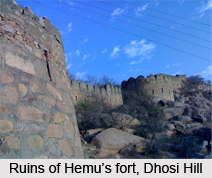 The remnants of a 500-year old fort are visible at several points of the Dhosi Hill, an extinct volcano standing alone in the northwest end of the Aravalli Mountain Ranges, at altitude varying from about 345 to 470 metres from the surrounding land and 1,170 metres above the sea level. The fort was built by Samrat Hemchandra Vikramaditya, who was known as Hemu, about over 500 years ago on the hill. The Dhosi Hill is situated in the ancient Vedic state of Brahmavarta, presently an area called Shekhawati on the borders of Indian states Rajasthan and Haryana. The hill, in addition to having temples, ponds and caves on the top and forest around it, also has the ruins of the fortress constructed by Hemu, fortified by a strong wall measuring about 25 feet (7.6 metres) in height and 40 feet (12 metres) in width, on even the steepest slopes and the top of the volcano. The fort was erected to safeguard the heritage and ashrams on the hill against the frequent Muslim invasions and attacks, during the medieval period.
The remnants of a 500-year old fort are visible at several points of the Dhosi Hill, an extinct volcano standing alone in the northwest end of the Aravalli Mountain Ranges, at altitude varying from about 345 to 470 metres from the surrounding land and 1,170 metres above the sea level. The fort was built by Samrat Hemchandra Vikramaditya, who was known as Hemu, about over 500 years ago on the hill. The Dhosi Hill is situated in the ancient Vedic state of Brahmavarta, presently an area called Shekhawati on the borders of Indian states Rajasthan and Haryana. The hill, in addition to having temples, ponds and caves on the top and forest around it, also has the ruins of the fortress constructed by Hemu, fortified by a strong wall measuring about 25 feet (7.6 metres) in height and 40 feet (12 metres) in width, on even the steepest slopes and the top of the volcano. The fort was erected to safeguard the heritage and ashrams on the hill against the frequent Muslim invasions and attacks, during the medieval period.
`Dhusar` was the other name of emperor Hemu and since he belonged to this region, the communities are referred to as Dhusar even today. During the 1890s, a fort was constructed on the Dhosi hill, which resembled the temple of Chyavana Rishi, to replace the old temple. The fort was built at the crater of the hill by the Bhargava community, also called Dhusar Brahmins.
Stone and lime plaster stairs have been made, suitable for all kinds of weather, on the sides of Thana and Kultajpur villages. However, currently the pony pathway leading from the Thana village and the way from the Dhosi village are in ruins. The stairs on the side of Kultajpur are one of the most convenient ways of reaching the summit of Dhosi Hill, being very wide, enabling visitors to relax along their journey. While journeying along the stairs of the fort, one shall be greeted with splendid views of the adjoining villages lining the Aravalli Ranges. Spectacular Shekhawati paintings are existent in the Chyavana Rishi Temple, in the Garbhagriha which is used as a resting place by the pilgrims. The `Chandrakoop` portion of the hillside fort is amongst the notable points, wherein the Raj Rishis had prepared a herbal solution for treating the skin maladies of Chyavan Rishi. Near the fort premise is also present an ancient well supplying drinking water to pilgrims and visitors. The Government of Haryana has also made arrangements for providing clean drinking water by lifting water mechanically from Thana village.
Related Articles:
Forts in India
Dhosi Hill
History of Dhosi Hill
Aravalli Mountain Ranges
Shekhawati, Rajasthan
Places of Interest in Shekhawati, Rajasthan
Shekhawati Region, Rajasthan
Medieval History of India
Chyavana, Indian Sage



















